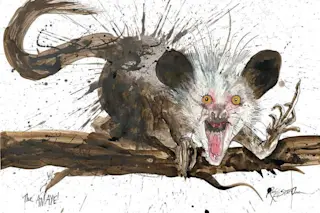Thanks to humans, our planet is facing its sixth great extinction. As their habitats dwindle or are destroyed altogether, many plants and animals are disappearing. That’s not much fun to think about. So, with that in mind, writer Ceri Levy sought out legendary illustrator Ralph Steadman. Among his many accolades, the British artist co-invented gonzo journalism — where the storyteller becomes the story — as an illustrator for the various works of lifelong friend Hunter S. Thompson, including Fear and Loathing in Las Vegas.
Levy asked Steadman to draw one particular endangered bird for an art exhibition. He agreed. But Steadman couldn’t stop at just one; he’s now drawn hundreds of endangered species. The pair have published three books together, including their latest, Critical Critters, excerpted here.
Steadman starts the process by spilling dirty ink water on a page, and then uses a “Ralphschach test” with Levy to see which ...















